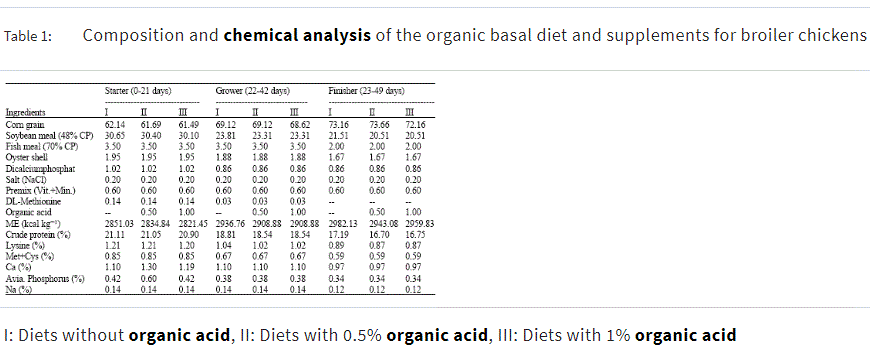Influence of Three Different Organic Acids on Broiler Performance
Abstract
This study was conducted in order to evaluate three different organic acids on broiler performance. The broiler performance has compared together with using RCD design with 7 treatments and 4 replicates which 420 day-old commercial Ross 308 chicks were divided into 28 groups. The six groups out of seven groups birds fed a diet with organic acids (citric, benzoic and tartaric acids) consist 0.5 or 1% level and one group fed with a diet control without organic acids for 49 days. The average of body weight gain, feed intake, feed conversion ratio and carcass percentage were analyzed and compared finally. The results showed no significant effects of diets with 0.5% organic acids (p<0.05) on all characters. One percent benzoic acid diets caused a significant decrease in the average of feed consumption from 21 to 42 days of age (p<0.05). The average weight gain at 21 to 42 days showed a significant decrease (p<0.05) that this effect was resulted of benzoic acid at 1% of dietary. There were no significant effects of organic acids dietary on carcass characteristics.
Key word: Broiler, Organic Acid, Performance.
Bartov, I., 1983. Effects of propionic acid and of copper sulfate on the nutritional value of diets containing moldy corn for broiler chicks. Poult. Sci., 62: 2195-2200.
Boling, S.D., D.M. Webel, I. Mavromichalis, C.M. Parsons and D.H. Baker, 2000. The effects of citric acid on phytate-phosphorus utilization in young chicks and pigs. J. Anim. Sci., 78: 682-689.
Chowdhury, R., K.M.S. Islam, M.J. Khan, M.R. Karim, M.N. Haque, M. Khatun and G.M. Pesti, 2009. Effect of citric acid, avilamycin and their combination on the performance, tibia ash and immune status of broilers. Poult. Sci., 88: 1616-1622.
Duncan, D.B., 1955. Multiple range and multiple F tests. Biometrics, 11: 1-42.
Falkowski, J.F. and F.X. Aherne, 1984. Fumaric and citric acid as feed additives in starter pig nutrition. J. Anim. Sci., 58: 935-938.
Fancher, B.I. and L.S. Jensen, 1988. Induction of voluntary feed intake restriction in broiler chicks by dietary glycolic acid supplementation. Poult. Sci., 67: 1469-1482.
Garcia, V., P. Catala-Gregori, F.M. Hernandez, D. Megias and J. Madrid, 2007. Effect of formic acid and plant extracts on growth, nutrient digestibility, intestine mucosa morphology and meat yield of broilers. J. Applied Poult. Res., 16: 555-562.
Jozefiak, D., D. Kaczmarek and A. Rutkowski, 2008. The effects of benzoic acid supplementation on the performance of broiler chickens. J. Anim. Physiol. Anim. Nutr., 94: 29-34.
Liem, A., G.M. Pesti and H.M. Edwards Jr., 2008. The effect of several organic acids on phytate phosphorus hydrolysis in broiler chicks. Poult. Sci., 87: 689-693.
Mroz, Z., A.W. Jongbloed, K. Partanen, K. Vreman, J.T.M. van Diepen, P.A. Kemme and J. Kogut, 1997. The effect of dietary buffering capacity and organic acid supplementation (formic, fumaric, or n-butyric acid) on digestibility of nutrients (protein, amino acids, energy and minerals), water intake and excreta production in growing pigs. ID-DLO Report No. 97. 014. Institute for Animal Science and Health, Branch Runderweg, Lelystad, The Netherlands.
Neu, H.C., 1992. The crisis in antibiotic resistance. Science, 257: 1064-1073.
Partanen, K.H. and Z. Mroz, 1999. Organic acids for performance enhancement in pig diets. Nutr. Res. Rev., 12: 117-145.
Patten, J.D. and P.W. Waldroup, 1988. Use of organic acids in broiler diets. Poult. Sci., 67: 1178-1182.
Patterson, J.A. and K.M. Burkholder, 2003. Application of Prebiotics and Probiotics in poultry production. Poult. Sci., 82: 627-631.
Ricke, S.C., 2003. Perspectives on the use of organic acids and short chain fatty acids as antimicrobials. Poult. Sci., 82: 632-639.
Roy, R.D., F.W. Edens, C.R. Parkhurst, M.A. Qureshi and G.B. Havenstein, 2002. Influence of a propionic acid feed additive on performance of turkey poults with experimentally induced poult enteritis and mortality syndrome. Poult. Sci., 81: 951-957.
Snow, J.L., D.H. Baker and C.M. Parsons, 2004. Phytase, citric acid and 1α-Hydroxycholecalciferol improve phytate phosphorus utilization in chicks fed a corn-soybean meal diet. Poult. Sci., 83: 1187-1192.
Dear Ebrahim
Looking to this trail is very difficult to draw a final conclusion about advantage of using organic acid in broiler production.
What I personally learned is the surprising low level of energy and protein in those feed formulations that anyway translate in higher feed conversation for those particular broilers.
In addition looks like your country is a soya/corn user (as main raw materials) for broiler production.
Best regards,
Viorel
I request to try the same with natural vegetable or herbal products, which contain the organic acids like for citric acid Lemon or Indian goose berry (Amla fruit), by which the results will be positive.
















.jpg&w=3840&q=75)